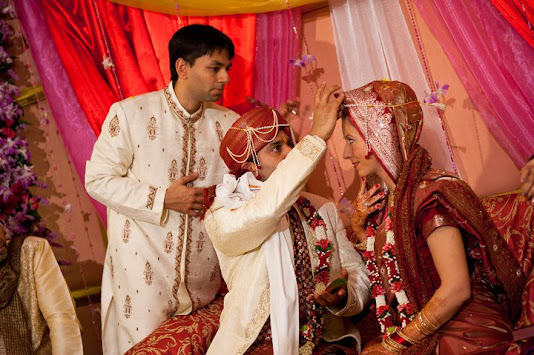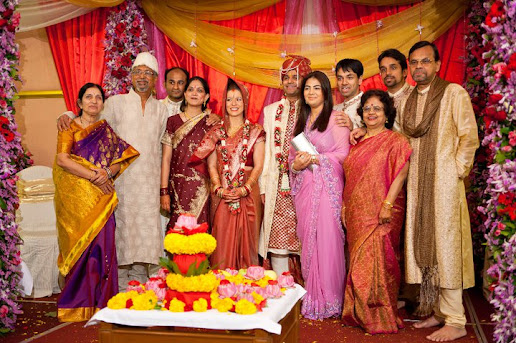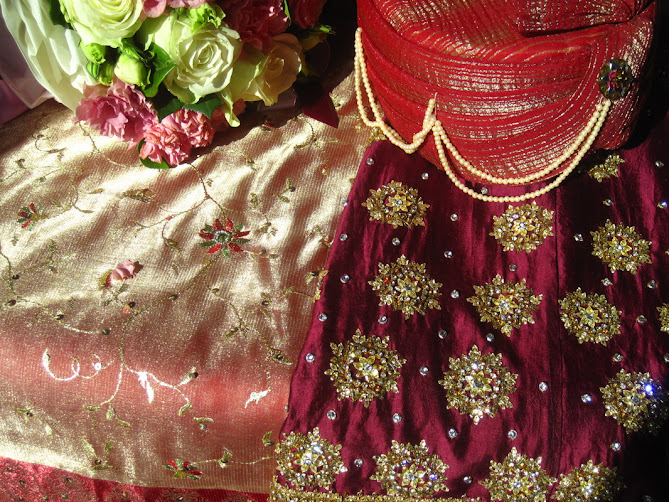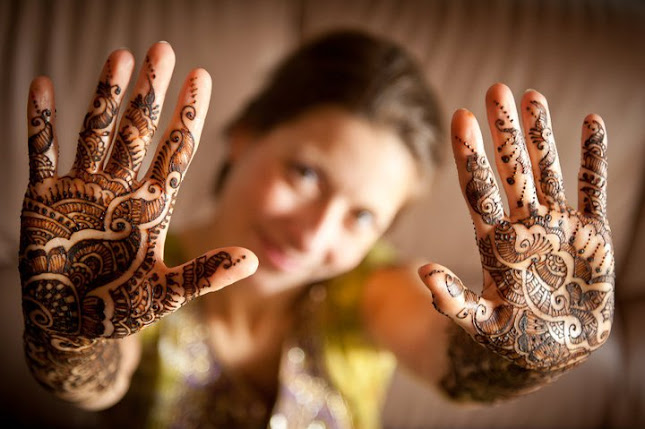Ganesh is a god after my heart, full of mischief and intelligence and completely lacking in self control where sweets are concerned.. much like my new husband whose name, incidentally means Ganesh in Marathi. One story tells of a young Ganesh headed home on the evening of his birthday after having stuffed himself silly on delicious ladoos and other tasty indian treats. His ride stumbles, having been spooked by a snake in the path, causing Ganesh to tumble clumsily to the ground, and in the fall his overly full belly bursts open, spilling his ladoos all over the ground. Ganesh quickly recovers and begins hastily collecting the ladoos, putting them back into his stomach, before grabbing the aforementioned snake and using it as a belt. The moon, having witnessed the entire hilarious seen, bursts into happy laughter at Ganesh’s expense. Ganesh Chaturthi (Ganesh’s birthday) is celebrated each year near the end of August or beginning of September with much feasting, abundant ladoos and an avoidance of meeting the moon’s mischievous eye ;)
In another story, it is said that Ganesh was created from mud by the goddess Parvati, wife to Shiva. Upon creation, she assigns him the task of watching the door while she bathes, ensuring that no one can interrupt her. Shortly after Ganesh takes his post, Shiva strolls up, demanding entrance. Not surprisingly, a fight ensues between the two and as expected of a god credited with being “The Destroyer,” an enraged Shiva throws his trident at Ganesh, beheading him. Moments later, a seriously pissed off Parvati threatens to destroy the entire world, abstaining only if Ganesh is brought back to life and is there forth acknowledged before any other gods. When faced with a wife dealing with severe anger management issues (I can relate) Shiva fumbles for a solution and thus our elephant headed Ganesh came about. As a result of Shiva’s mishap and Parvati’s demand, Ganesh is invoked before all other gods at the start of any pooja (prayer.) He is known as the remover (and occasionally the placer) of all obstacles and as marriages tend to be full of obstacles, I am certain that our pandit (priest) sent a prayer his way at the start of our wedding. I know I was sending prayers to anyone and everyone who would listen!
We had arrived at the hotel and had successfully navigated the stairs without any high heeled induced mishaps and I stood awkwardly adorned in my bridal finery in front of countless cameras while waiting for someone to tell me where to go next. To break the tension, I had taken out my tiny Canon camera and was taking pictures of the photographers when the camera was wrest from my grip at the request of my soon to be sister-in-law. Two minutes later I triumphantly tucked my camera back into one of the many folds of my saree for the duration of the ceremony (one can fit many things discretely in the folds of a nine yard saree...money, cameras, makeup, food, spare clothes, small animals..)
My soon-to-be husband walked to my side and we humorously sized each other up, me in my Indian garb and him in his borrowed shoes and hat. He had forgotten the original shoes and hat in Chicago but chose not to tell me till we reached Bangkok in fear of provoking a Shiva style rage. (Seriously though...I packed/did Everything!! All he had to do was remember the hat and shoes...sheesh!)
Ameya looked every ounce a raja in his pointy gold shoes, loose cotton cream colored pants, long silk red vest, soft cream coat with red embroidery, and lovely turban style red hat (sherwani.) I looked quite nearly Indian in my beautiful red and pink saree with delicate gold embroidery, countless red, gold and silver bangles and pretty jewels following the line of my eyebrows on my forehead. I was especially fond of my bindi which perfectly covered my ever deepening wrinkle, rendering me with a deceptively youthful appearance (or so I told myself.) A bindi is a pretty jewel worn by women between the eyebrows. I later read that the space between the brows is known as the sixth chakra (physical point of energy) otherwise known as “the seat of concealed wisdom.” I have never heard such a romantic phrasing for a simple wrinkle...
In another story, it is said that Ganesh was created from mud by the goddess Parvati, wife to Shiva. Upon creation, she assigns him the task of watching the door while she bathes, ensuring that no one can interrupt her. Shortly after Ganesh takes his post, Shiva strolls up, demanding entrance. Not surprisingly, a fight ensues between the two and as expected of a god credited with being “The Destroyer,” an enraged Shiva throws his trident at Ganesh, beheading him. Moments later, a seriously pissed off Parvati threatens to destroy the entire world, abstaining only if Ganesh is brought back to life and is there forth acknowledged before any other gods. When faced with a wife dealing with severe anger management issues (I can relate) Shiva fumbles for a solution and thus our elephant headed Ganesh came about. As a result of Shiva’s mishap and Parvati’s demand, Ganesh is invoked before all other gods at the start of any pooja (prayer.) He is known as the remover (and occasionally the placer) of all obstacles and as marriages tend to be full of obstacles, I am certain that our pandit (priest) sent a prayer his way at the start of our wedding. I know I was sending prayers to anyone and everyone who would listen!
We had arrived at the hotel and had successfully navigated the stairs without any high heeled induced mishaps and I stood awkwardly adorned in my bridal finery in front of countless cameras while waiting for someone to tell me where to go next. To break the tension, I had taken out my tiny Canon camera and was taking pictures of the photographers when the camera was wrest from my grip at the request of my soon to be sister-in-law. Two minutes later I triumphantly tucked my camera back into one of the many folds of my saree for the duration of the ceremony (one can fit many things discretely in the folds of a nine yard saree...money, cameras, makeup, food, spare clothes, small animals..)
My soon-to-be husband walked to my side and we humorously sized each other up, me in my Indian garb and him in his borrowed shoes and hat. He had forgotten the original shoes and hat in Chicago but chose not to tell me till we reached Bangkok in fear of provoking a Shiva style rage. (Seriously though...I packed/did Everything!! All he had to do was remember the hat and shoes...sheesh!)
Ameya looked every ounce a raja in his pointy gold shoes, loose cotton cream colored pants, long silk red vest, soft cream coat with red embroidery, and lovely turban style red hat (sherwani.) I looked quite nearly Indian in my beautiful red and pink saree with delicate gold embroidery, countless red, gold and silver bangles and pretty jewels following the line of my eyebrows on my forehead. I was especially fond of my bindi which perfectly covered my ever deepening wrinkle, rendering me with a deceptively youthful appearance (or so I told myself.) A bindi is a pretty jewel worn by women between the eyebrows. I later read that the space between the brows is known as the sixth chakra (physical point of energy) otherwise known as “the seat of concealed wisdom.” I have never heard such a romantic phrasing for a simple wrinkle...
After just a few minutes chatting, Ameya was led away to take his seat under the mandap (outrageously flowery canopy under which we were to be married) and I was led to a seat in the front row to observe. The first part of the ceremony consisted of the parents of the bride blessing their future son-in-law and entrusting him with the care of their daughter. I later asked Ameya about the significance of each action within the ceremony such as why Mahapatra Uncle poured water into his hand with a spoon and what was the deal with the short bit of string they held between them. His response was a clarifying “I have no idea.”
A few moments later, I was led to the Mandap where Ameya and I stood facing each other with a silk cloth held between us, blocking our view. My ceremonial brother, Sid held one end and impishly peeked over to my side while Ameya’s cousin Shishir held up the other. In past traditional weddings, the dropping of this cloth was the moment in which the bride and groom see each other for the first time. I can’t even begin to imagine.. After feigning happy surprise once the cloth was dropped, we exchanged beautiful flowered garlands and namastes (Jai Mala..formal acceptance and respect) before taking our seats, mine to the right of his in order to be symbolically closer to his heart.
Our particular ceremony was an Arya Samaj wedding, which meant that while all of the prayers and chants were in Sanskrit, they were then translated to hindi, and from hindi to english. From what I understand, our particular pandit (priest) is much sought after and upon returning to Bangkok from their Chicago visit last summer, Ameya’s parents consulted an astronomer for auspicious dates and immediately booked our pandit. (Despite the fact that Ameya himself had yet to ask me to marry him..) Our pandit was a tall, friendly looking man whose hair had deserted the top of his head in favor of his ears, giving him an endearingly sweet and approachable appeal. He had a clear yet not overpowering voice, steady hands and didn’t seem to take any notice at all of the suspiciously pale hue of the bride. He traversed three languages in a way I will forever envy, and his english translations gave voice to his particular brand of humor. For example, when translating a vow that we were making to do things together as a couple, his english equivalent was, “even if you go to a club, you have to take her with.”
Ameya and I sat shoeless on a red draped couch surrounded by four flower pillars, his parents to his left, my parents (the Mahapatras) to my right and a small sacred fire in front of us (dangerously close to my vast yardage of saree and torchlike hair.) Fire (agni) represents a purifying agent making it central to the ceremony and out of respect, we dropped handfuls of flowers in the small fire before Ameya’s parents offered symbolic gifts of clothing to the Mahapatras.
We then had strands of white beads placed on each of our heads by Ameya’s eldest aunt, who understandably struggled a bit with his hat. Our pandit placed my hand palm up in M. Uncle’s and fit Ameya’s hand under his. My adopted brothers Sid and Vivek alternately trickled water over the joined hands as Uncle removed his hand, placing mine in my husband’s and giving me into his care. Our pandit draped scarfs over Ameya’s and my shoulders, tying each end as securely as we were tying our lives and families together. Chanting began and Ameya was instructed to give a single word response while dipping a long spoon into a small bowl of ghee (clarified butter) before feeding it to the sacred fire. I relaxed at this point as the endless chanting was having a lulling effect. My nearly husband was obliged to drop approximately 600 spoonfuls of ghee on the fire, each drop of course, requiring in depth instructions from his dad. As Ameya’s days leading up to the wedding had been considerably calmer than mine, I sat back and found vindictive joy in the line of sweat trickling down the side of his face as he hastily attempted to please his family with the quality of his ghee pouring. I probably would have been even more smug had I already known that I would not have to repeat the same task five minutes later.
Weighed down with yards of material, flower garlands, white beads and knotted scarves, Ameya and I were instructed to stand and begin our seven pheras (circles) around the sacred fire, (without inadventently setting Bangkok alight.) At the start of each phera, Sid (the brides brother) filled my hands with puffed rice which together Ameya and I poured on the sacred fire causing a popcorn like scent to fill the air. (bringing the fact that I was starving to my attention..) I led the first three pheras of which halfway through, I placed my foot on a grindstone while more chanting commenced. The grindstone signified both the strength of our marriage and the obstacles we would overcome. Each phera had a specific purpose and prayer; the first phera for a healthy respectful life together, the second for the ability to be strong and complement each other, the third for wisdom and prosperity, the fourth for faithfulness to each other and each others families, the fifth for the love of friends, family and charity, the sixth for a happy long life together and the seventh for the bond of friendship and loyalty to each other.
Unlike a typical christian wedding ceremony where everyone sits as quiet obedient witnesses, indian ceremonies tend to be a bit noisier. (and definitely more colorful!) Throughout the approximately 90 minute ceremony, guests chatted aimlessly, hugged friends and relatives, drank tea and coffee and in a few cases of young cousins and old aunties and uncles... dozed off. However, once the pheras began, guests perked up, and discreet elbows to those who had nodded off could be seen. Not wanting to give into the entertainment value of tripping over my saree and grindstone, clumsily pulling my husband and myself into the sacred fire, I walked at an excessively sedate pace, unintentionally giving the image of a meek humble bride.
After completing our seven pheras, we were again seated and 7 leaves with seven spoonfuls of rice were placed at my feet. These signified our seven steps together. For each ‘step’ Ameya made a specific vow and to show my agreement, I flicked the rice from the corresponding leaf using my toes. The first step signified our vow to share the responsibilities of married life, the second to fill each other with strength and courage, the third to work together for prosperity, the fourth to cherish each other in happiness and sorrow, the fifth to raise strong virtuous children, the sixth to fill each other with joy and the seventh to be lifelong partners. I suspect that at this point Ameya was slightly jealous because while he had to pour endless ghee, I got to play soccer with rice..
Our pandit held a leaf with red vermillion powder in front of Ameya who dipped in his right hand ring finger in the mixture before turning to me. He raised his red coated finger to my forehead and clumsily placed a red mark near the part in my hair, marking me as a married woman. (sindoor) Later, our friend Sabah dabbed at my forehead in an attempt to make me look less like a bludgeoned woman and more like a wife.
Finally, a prayer was said over a lovely intricate black and gold necklace which is the traditional indian version of a wedding ring. (Mangal sutra) With the help of his mom, Sid, and Sid’s wife Namrata, Ameya awkwardly handled the delicate necklace, eventually managing to hook it around my neck.
A final prayer was said and the ceremony ended with smiles, rice throwing, hugging, feet touching, grumbling empty stomachs and necessary posing for millions of pictures. As things eventually began to wind down, I imagined myself gorging on pounds of spicy paneer and countless numbers of tiny tea cakes which I had been eying all morning. Ameya and I headed toward the two stairs taking us from the mandap and to the glorious array of food, only to discover that his shoes were missing. Having easily found mine and in a desperate search for food, I quickly and shamelessly deserted my husband to the tradition of bargaining with his new in-laws for the return of his shoes. Marriage had truly begun...












































